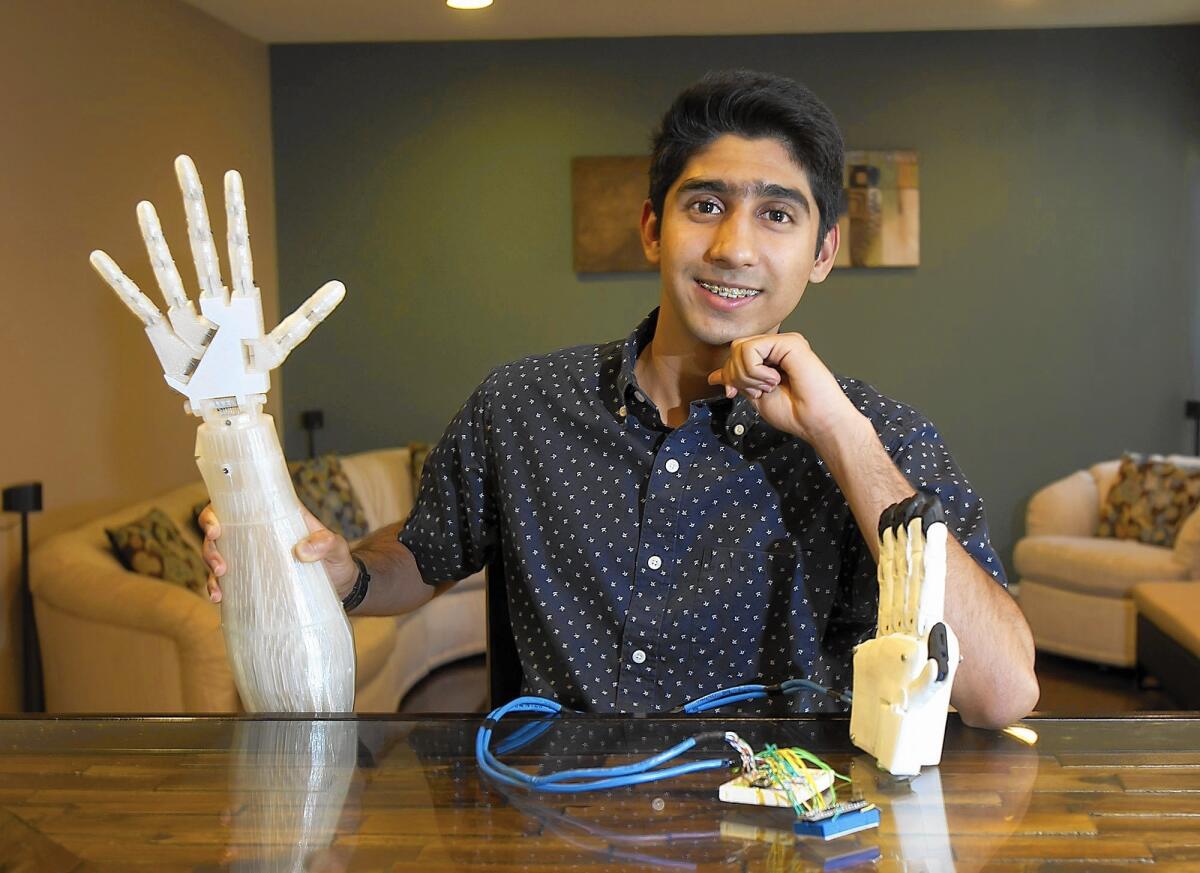Student’s robotic arm wins awards and accolades

Irvine High School student Nilay Mehta, 17, with an InMoov robotic arm and hand. Nilay programmed the device and entered his project in three sciences fairs this past spring.
Irvine High School student Nilay Mehta has always had an interest in hands-on science.
So perhaps it is not unusual that while the 17-year-old was brainstorming ideas for his science fair project, he came up with a plan for a robotic arm. He then spent more than four months building it, programming the arm’s hand to replicate the movements of a human hand.
The creation has won the senior six science fair awards, including third place at an international fair in May.
Nilay had been practicing for this undertaking most of his life. Growing up, he took the pieces out of old computer monitors and watches to see what he could build with them. He’s spent summers constructing projects, like small moving cars made of just wood and a fan, while participating in the Irvine Public Schools Foundation’s Summer Enrichment Academy.
Last summer, Nilay began researching project ideas for the science fairs he wanted to enter this year.
“I was confused about what direction I would take,” Nilay said. “But I knew I wanted to do something in prosthetics. One issue I saw is that there were no lower-cost options.”
During this research period, Nilay said, he discovered that high-end prosthetic arms cost upward of $35,000. Motors and 3D-printed parts used to make his arm added up to about $260.
His project, which takes the shape of a forearm and hand, operates by voice command. By speaking into a small microphone attached to the arm, the user can make the hand perform specific movements.
“You can say ‘spoon’ and the hand will make a shape that will be able to hold a spoon,” Nilay said.
The hand can also simulate “pinch,” “grab” and other common figurations that he determined were important as he learned about hand dexterity.
Along with cost, he wanted the project to help solve another problem for certain amputees — the ability to easily upgrade the prosthesis.
“For kids who are growing, they have to change their prosthetics every six to eight months,” Nilay said.
He finalized his idea in October and began 3D-printing the parts the following month. Even with his load of Advanced Placement courses in school, Nilay said, he devoted countless hours to tinkering with the arm.
In late February, he first entered the arm in a district science fair sponsored by the Irvine Public Schools Foundation.
After taking home the blue ribbon from that event, Nilay and his project qualified in April for the Orange County Science and Engineering Fair at the Orange County fairgrounds — where he won four first-place awards.
When he applied for that fair, his application also went before a separate judging panel looking to send four students to the 2015 Intel International Science and Engineering Fair. Nilay was chosen and attended that fair in May.
“I was really inspired by Nilay,” Eugenia Gabrielova, a PhD candidate in software engineering at UC Irvine and a panel judge for the county science fair, said. “I think Nilay’s robotic arm has potential for use by patients because of its affordable price point and multi-finger gesture approach.”
The Intel fair, held in Pittsburgh this year, invited nearly 1,800 students from 78 countries to showcase their projects. Nilay’s journey to the six-day fair was his first trip to the East Coast.
“It was all really new to me,” Nilay said. “It was great to be surrounded with like-minded people. I was really nervous but getting there validated everything I did up until that point.”
Out of the hundreds of project entries, he and his robotic arm took third place in the biomedical and health sciences category.
He said he plans to develop the arm further and enter more science fairs.
“I’m done with the software,” Nilay said. “What I’m trying to do now is work on usability and design. Hopefully someday it can be tested with an amputee and I can work on that process from there.”